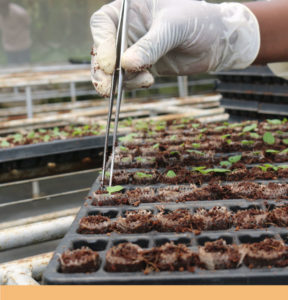Putting the world’s largest potato collection in the deep freeze
The International Potato Center (CIP) is conserving the future of potato genetic diversity in the world’s largest potato cryobank and setting new standards to transform the way that other priority clonal crops like sweetpotato and yams are held in safe storage. These innovations ensure we have an essential backup collection of the clonal crops that 300 million smallholders in developing countries depend on – for their food security and livelihoods.
A race against time
The ‘6th Mass Extinction’ of an estimated one million species is largely driven by human activity that is pushing the planet beyond sustainable boundaries, altering the climate, and degrading the environment. While international headlines focus on threats to better-known wild species like the snow leopard, we often overlook another story: the threats to the genetic diversity that supports our food systems.
Potato, for example, is one of the most biodiverse staple crops in the world. In the Andean region, where it originated, more than 4,500 potato landraces belong to seven different species. Yet varieties are disappearing at an alarming rate, including traditional local landraces maintained by farmers across millennia and ancient wild potato ancestors. Each species holds unique genetic keys that could unlock ways to help us produce nutritious food in a changing climate and prepare for future threats, such as novel viruses. Simply put, we need to conserve plant genetic diversity to ensure we have the options to secure our food supply and the livelihoods of millions of people.
A cool conservation innovation
Many priority food security crops like potato and sweetpotato, and cash crops like coffee and cacao, are clonal crops which means they cannot be conserved by seed. The UN Food and Agriculture Organization estimates that clonal crop production accounts for one billion metric tons of food a year, valued at USD 100 billion.
Conserving the genetic diversity contained in these crops can be challenging and expensive. One way is by conserving them as in vitro plantlets. The International Potato Center (CIP) maintains the world’s most diverse in vitro collection in its genebank where it stores 12,000 accessions of potato, sweetpotato, and other Andean root and tuber crops. In addition to its in vitro collection, CIP has built the world’s largest and most diverse potato cryobank collection where 3,600 accessions are held in safe long-term storage.
“While in vitro and field collections work well to maintain genetic diversity in the short- to medium- term, it can be expensive and unreliable in the long-term,” explains Rainer Vollmer, a cryopreservation expert at CIP. “Accessions held in vitro must be continually propagated while field collections are vulnerable to natural disasters or conflict. Thus, cryopreservation is a cost-effective and reliable alternative. Today, a single person can cryopreserve 300-450 potato shoot tips in one working day.”
Cryopreservation uses liquid nitrogen (196°C) to rapidly freeze tiny tissue samples taken from sterile in vitro plantlets. For potatoes, samples are usually taken from the root tip. Once frozen, the samples can stay suspended in time until they are needed. Once they come out of the cryobank, the samples can be developed into complete plants around 6-8 weeks after thawing and shared with institutions around the world.
As one of CGIAR’s eleven genebank collections, the potato collection at CIP is maintained as a global public good, with samples shipped out to researchers and breeders on request under the auspices of the International Treaty on Plant Genetic Resources for Food and Agriculture. Germplasm from CIP’s collections has been used in more than 100 countries for breeding purposes.
The potato that came in from the cold
Different varieties of different plants need cryo-protocols appropriate to their species, which must be constantly reviewed and updated. For example, scientists at CIP updated the protocol for potato cryopreservation by testing different treatments to a mix of cultivated and wild varieties before they went into the cryobank (e.g., adding sucrose or a chemical to help the samples withstand the cold). Results showed that while adding sucrose had no noticeable effect, using the cold treatment before freezing improved recovery rates by 14%.
“This process can be adapted and applied to other potato varieties and potentially to other clonal crops like sweetpotato which does not yet have established protocols,” says Vollmer. “Of course, conserving potato diversity is only half of the story. It also needs to be used in breeding programs to help farmers face challenges like crop diseases and climate change. The availability of diverse germplasm is one of the most critical elements in breeding new and improved varieties.”
The Victoria potato variety in Uganda is a case in point. Late blight disease in potato can destroy up to 60% of yields, which is devastating to the country’s 300,000 potato farmers. The Victoria variety was developed with CIP germplasm to make it resistant to late blight and the effects have been profound. Over the past 15 years, Victoria has contributed an estimated USD 1 billion over 15 years to the Ugandan economy and 72% of that value can be directly attributed to germplasm from CIP. And this work is continually evolving. An improved variety of Victoria currently in development is using genes from two wild potato ancestors to enhances its resistance to late blight.
Pandas and potatoes
In October 2021, world leaders will agree on the next set of Global Biodiversity Goals, designed to galvanize efforts to build a better future in harmony with nature, and to deliver across the 2030 Agenda for Sustainable Development. The need to conserve our food species as well as our wildlife is a critical part of achieving those goals. Our success will depend on transformative solutions like the innovations developed by CIP to conserve wild and domesticated varieties of potato, sweetpotato, and other Andean root and tuber crops.


